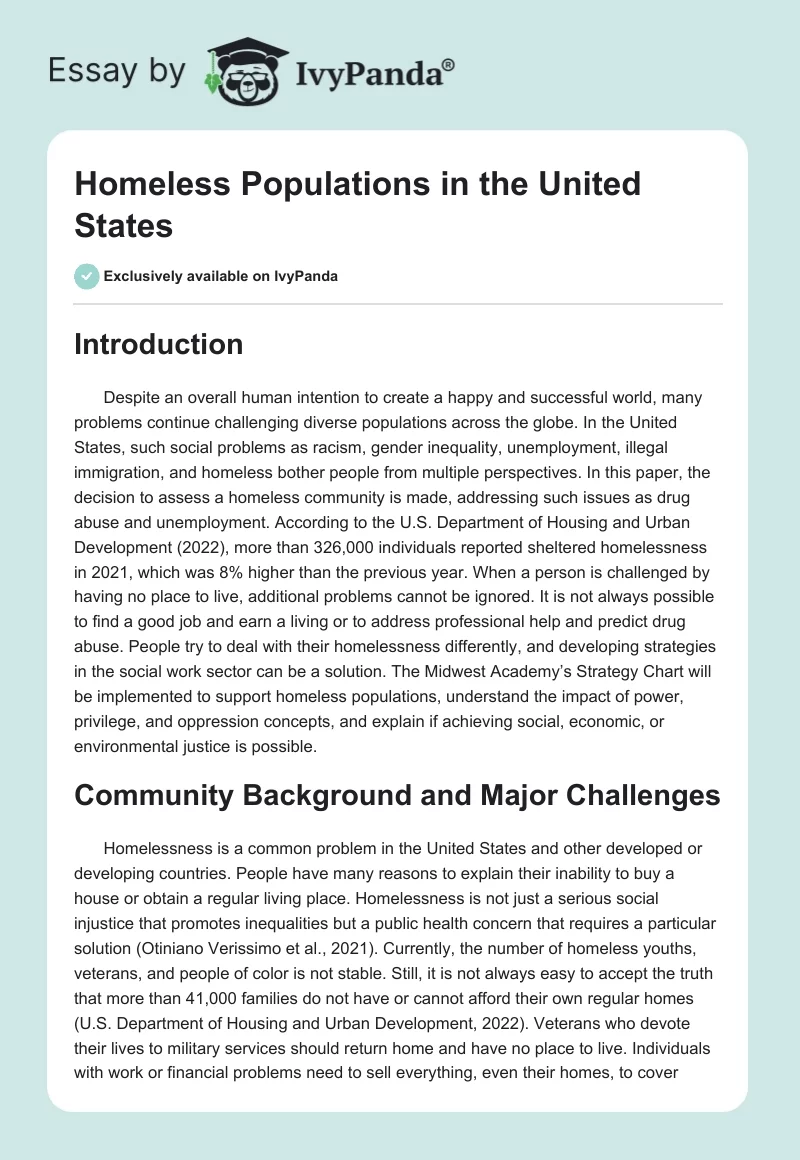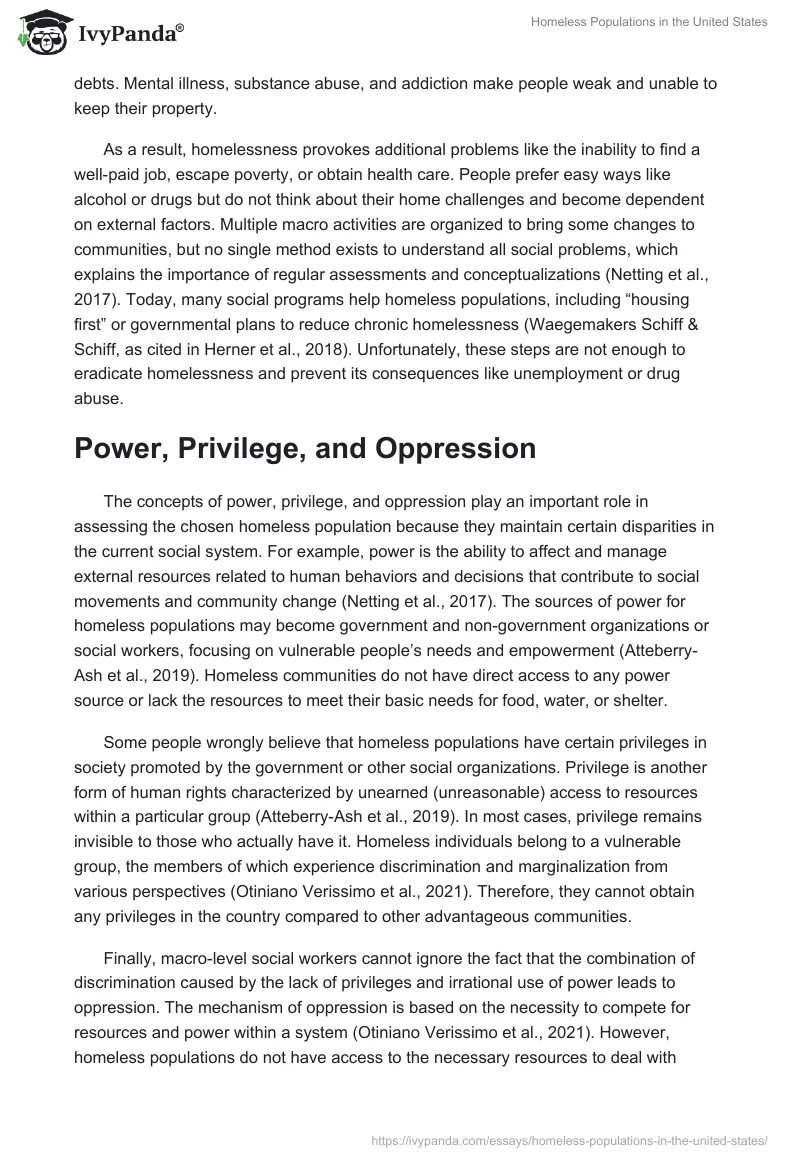Introduction
Despite an overall human intention to create a happy and successful world, many problems continue challenging diverse populations across the globe. In the United States, such social problems as racism, gender inequality, unemployment, illegal immigration, and homeless bother people from multiple perspectives. In this paper, the decision to assess a homeless community is made, addressing such issues as drug abuse and unemployment. According to the U.S. Department of Housing and Urban Development (2022), more than 326,000 individuals reported sheltered homelessness in 2021, which was 8% higher than the previous year. When a person is challenged by having no place to live, additional problems cannot be ignored. It is not always possible to find a good job and earn a living or to address professional help and predict drug abuse. People try to deal with their homelessness differently, and developing strategies in the social work sector can be a solution. The Midwest Academy’s Strategy Chart will be implemented to support homeless populations, understand the impact of power, privilege, and oppression concepts, and explain if achieving social, economic, or environmental justice is possible.
Community Background and Major Challenges
Homelessness is a common problem in the United States and other developed or developing countries. People have many reasons to explain their inability to buy a house or obtain a regular living place. Homelessness is not just a serious social injustice that promotes inequalities but a public health concern that requires a particular solution (Otiniano Verissimo et al., 2021). Currently, the number of homeless youths, veterans, and people of color is not stable. Still, it is not always easy to accept the truth that more than 41,000 families do not have or cannot afford their own regular homes (U.S. Department of Housing and Urban Development, 2022). Veterans who devote their lives to military services should return home and have no place to live. Individuals with work or financial problems need to sell everything, even their homes, to cover debts. Mental illness, substance abuse, and addiction make people weak and unable to keep their property.
As a result, homelessness provokes additional problems like the inability to find a well-paid job, escape poverty, or obtain health care. People prefer easy ways like alcohol or drugs but do not think about their home challenges and become dependent on external factors. Multiple macro activities are organized to bring some changes to communities, but no single method exists to understand all social problems, which explains the importance of regular assessments and conceptualizations (Netting et al., 2017). Today, many social programs help homeless populations, including “housing first” or governmental plans to reduce chronic homelessness (Waegemakers Schiff & Schiff, as cited in Herner et al., 2018). Unfortunately, these steps are not enough to eradicate homelessness and prevent its consequences like unemployment or drug abuse.
Power, Privilege, and Oppression
The concepts of power, privilege, and oppression play an important role in assessing the chosen homeless population because they maintain certain disparities in the current social system. For example, power is the ability to affect and manage external resources related to human behaviors and decisions that contribute to social movements and community change (Netting et al., 2017). The sources of power for homeless populations may become government and non-government organizations or social workers, focusing on vulnerable people’s needs and empowerment (Atteberry-Ash et al., 2019). Homeless communities do not have direct access to any power source or lack the resources to meet their basic needs for food, water, or shelter.
Some people wrongly believe that homeless populations have certain privileges in society promoted by the government or other social organizations. Privilege is another form of human rights characterized by unearned (unreasonable) access to resources within a particular group (Atteberry-Ash et al., 2019). In most cases, privilege remains invisible to those who actually have it. Homeless individuals belong to a vulnerable group, the members of which experience discrimination and marginalization from various perspectives (Otiniano Verissimo et al., 2021). Therefore, they cannot obtain any privileges in the country compared to other advantageous communities.
Finally, macro-level social workers cannot ignore the fact that the combination of discrimination caused by the lack of privileges and irrational use of power leads to oppression. The mechanism of oppression is based on the necessity to compete for resources and power within a system (Otiniano Verissimo et al., 2021). However, homeless populations do not have access to the necessary resources to deal with oppression. They may find cheap drugs, free but low-quality food, and jobs with small/minimal salaries. Still, it is hard to neglect or change the already engrained system of oppression and inequality.
Strategy Chart & Needs Assessment
The Midwest Academy Strategy chart is a strategic planning tool that provides macro-level social workers with a framework to gather information about a vulnerable group and promote informed action. Compared to other approaches where time-frames and statistics are critical, this chart is the best way to identify the goals, considerations, participants, targets, and tactics. Homeless populations have disproportionately negative health outcomes, high drug addiction rates, and mental health problems (Anderson et al., 2021). At the same time, structural privileges and oppression lead to poor employment levels and housing access (Otiniano Verissimo et al., 2021). Following the chosen chart, the goals are improving care services and creating new working places for homeless people. The campaign may be funded by the government and non-profit organizations that volunteer to support the vulnerable group. The chart helps identify who might be responsible for the problem and power sources that can offer effective solutions. Tactics like media events, public speaking, and negotiations will result in a visualization of the population and attraction of the real stakeholders.
The basic needs of the homeless populations are food, shelter, healthcare, communication, and employment. According to Pruger (as cited in Netting et al., 2017), macro-level social work roles are to be the helper (assist clients in different situations) and to be an organizer (make reports and attend meetings). Regarding the high-level responsibility of social workers, it is expected that these experts might participate in the strategy in both roles. On the one hand, they need to communicate with homeless people, gather information about their current problems, examine their knowledge and potential contributions, and make observations to prove a vulnerability. On the other hand, it is not enough to cooperate with the chosen population but ensure their findings are discussed with those who obtain real power and privileges (the government, healthcare providers, and employers). These steps will facilitate the strategy and discover new effective solutions.
Alignment with Social Work Values
The main idea of the strategy to help homeless populations deal with drug addiction and unemployment is to invite stakeholders who can change the situation. Healthcare practitioners should find time to cooperate with the community and educate them about drug addiction. Employers may introduce reliable working places as a part of their support programs. This approach would align with social work values in several ways. Social justice is a value to promote fair and impartial support and define how differences shape human lives (Atteberry-Ash et al., 2019). All people have equal rights to meet their needs for shelter and food, which becomes the core issue in homeless help. Social workers do not always promote economic justice because these people do not have direct access to financial resources. Still, this value predicts the success of the chosen strategy, and the search for reliable sources is an important step. Most homeless people live in harsh environments characterized by health risks and threats (Anderson et al., 2021). Environmental justice may be promoted through practices and policies to improve living conditions for homeless individuals and recognize them as vulnerable groups that need help.
Conclusion
In general, the problem of homelessness in the United States cannot be solved in one day or even a year. Multiple steps are necessary to understand why people lose their homes, prefer addictive behaviors, and cannot find well-paid jobs to meet their basic needs. The Midwest Academy Strategy chart is an ideal way to initiate new programs and involve more social workers and other profit or non-profit organizations. Homeless populations cannot improve their living conditions without extra help. They do not have enough power or privileges and suffer from oppression at different levels. This project shows why homelessness is a critical issue for consideration and creates a solid background to develop new policies and programs to support the chosen vulnerable community.
References
Anderson, M. C., Hazel, A., Perkins, J. M., & Almquist, Z. W. (2021). The ecology of unsheltered homelessness: Environmental and social-network predictors of well-being among an unsheltered homeless population.International Journal of Environmental Research and Public Health, 18(14). Web.
Atteberry-Ash, B., Nicotera, N., & Gonzales, B. (2019). Walk the talk of power, privilege, and oppression: A template analysis.Journal of Social Work Education. Web.
Herner, M., Parker, C., McClellan, N., Muscato, L., & Guenther, E. (2018). Unmet needs of homeless at a shelter in an area undergoing urbanization. Journal of Rural and Community Development, 13(2), 100-109.
Netting, F. E., Kettner, P. M., McMurty, S. L., & Thomas, M. L. (2017). Social work macro practice (6th ed.). Pearson.
Otiniano Verissimo, A. D., Henley, N., Gee, G. C., Davis, C., & Grella, C. (2021). Homelessness and discrimination among US adults: The role of intersectionality. Journal of Social Distress and Homelessness. Web.
U.S. Department of Housing and Urban Development. (2022). HUD releases 2021 annual homeless assessment report part 1. HUD. Web.


